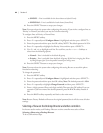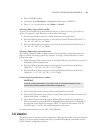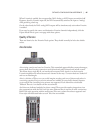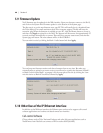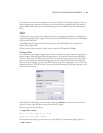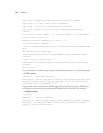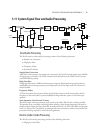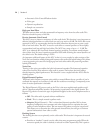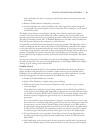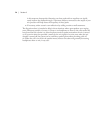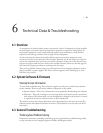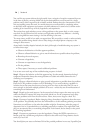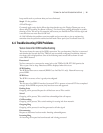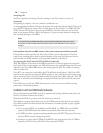72 | Section 5
Automatic Gain Control/Platform leveler ♦
Noise gate ♦
Dynamic equalization ♦
Sample rate conversion ♦
High-pass ‘hum’ Filter
is filter removes hum and other unwanted low frequency noise from the caller audio. is
filter has a break frequency of 100 Hz.
Receive Automatic Gain Control
is AGC serves to improve consistency of caller audio levels. is function is very important to
effective hybrid performance as caller levels can vary by as much as 30 dB. e Nx12 offer a new
approach to AGC to accommodate the fact that loud callers have become just as great a prob-
lem as low-level callers. e AGC is reset for each caller to a neutral position. to most-rapidly
accommodate both low and high-level callers. e AGC has a range of up to +/- 12 dB. e
AGC is an advanced dB- linear feed-forward topology providing a consistent sound indepen-
dent of drive level. Its ‘smart’ operation normalizes levels while retaining the natural dynamics of
the caller’s voice. e default setting is FULL.
An important additional feature of this AGC is that it is cross-coupled to other sections of the
Nx12 and can therefore reliably distinguish between caller audio and hybrid leakage. is allows
a more aggressive gain control for bringing up low-level callers while still preserving excellent
hybrid performance.
Noise Gate
Turning on the noise gate enables the built-in downward expander. e downward expander
reduces low level line noise when no caller audio is present. And reduces low level leakage
thereby improving hybrid performance. is function is cross-coupled with the AGCs and the
ducking system.
Digital Dynamic Equalizer
Telephone audio frequency response varies widely as many different factors can effect it (we’ve
measured the response on a number of calls and the results were revealing). Consequently, some
form of receive equalization is desirable.
e Digital Dynamic EQ process used on the Telos is the most sophisticated equalizer avail-
able in a broadcast telephone interface. All processing is performed in the digital domain. e
Receive EQ selection controls the type of equalization applied to the receive telephone audio as
follows:
Off
♦ - e caller audio is passed without modification.
Fixed
♦ - is is a simple manual equalizer mode.
Adaptive
♦ (Digital Dynamic) - is is a three band dynamic equalizer. We’ve chosen
frequency breakpoints, time constants, and other characteristics to optimize the tonal
quality of varied telephone callers. e user-entered EQ values are used as ‘target levels’.
is allows you to customize the caller spectral characteristics, but still get a consistent
spectral characteristic from caller to caller.
Ducking System
e ducking function occurs primarily on the caller audio. is function is important for several
reasons:
Provides an “aesthetic” control over the caller that many programmers prefer. When the
♦
announcer speaks, the caller is ducked, or reduced in volume dynamically. is is particu-



